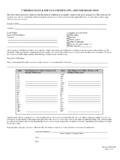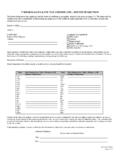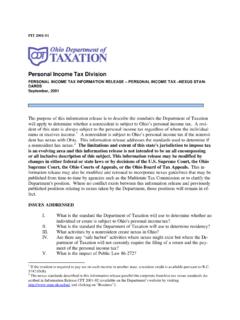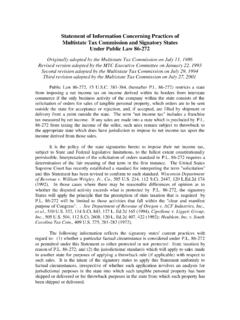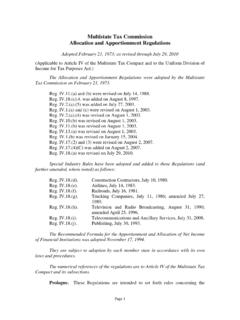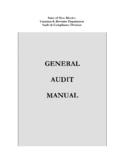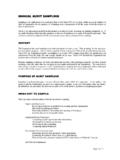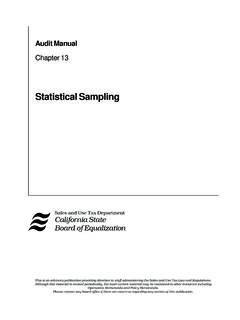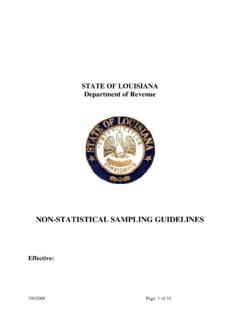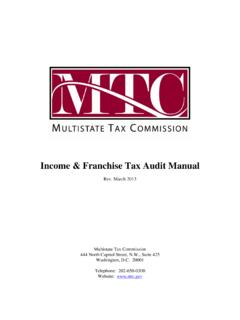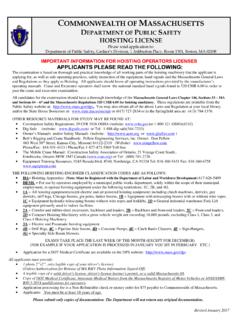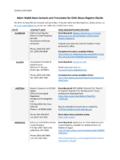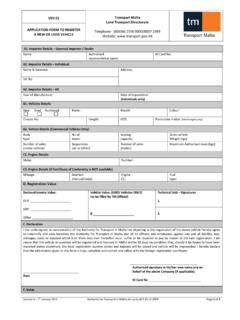Transcription of www.mass.gov/dor A Guide to Computer Assisted …
1 Commonwealth of Massachusetts Department of Revenue Computer Assisted Audit Group 617-887-6996. A Guide to Computer Assisted Audit Techniques T H I S PA G E. L EF T B L A N K. I N T E N T I O N A L LY. General Information Computer Assisted Auditing Techniques Your company has been selected for audit by the Massachusetts Depart- ment of Revenue. Our goal is to determine the proper tax due and propose any adjustments to the tax reported, with minimal time and expense to your company and the Department of Revenue. Computer Assisted Audit Tech- niques (CAATS) is an important tool in attaining that goal. The Department of Revenue has invested in software that allows us to accept electronic records from virtually any bookkeeping or financial accounting system. If you submit your records electronically we can quickly select a statistically valid sample of transactions on which to base our audit.
2 We do this work from our office, saving your staff time and inconvenience. Integrating CAATS into the audit process is part of our commitment to streamline the audit process. Our goal is to complete an efficient, under- standable and accurate audit. We will provide an audit trail consistent with Generally Accepted Accounting Principles. Our CAATS program is based on a tested and sound database application and informed judgment. This booklet is a basic introduction. DOR maintains additional information online at You may also request more detailed informa- tion regarding specific aspects of CAATS by contacting the Computer Assisted Audit Group at 617-887-6996. What is a Computer Assisted Audit? Audit functions formerly performed manually are now performed using stan- dard financial accounting software, modified as necessary for a particular system.
3 Generally, much of the same information is requested and analyzed as in a traditional audit. Once verified using Computer techniques, data is retained so it can be used in other areas of the audit including error identi- fication and segregation of transactions within accounts. Customized re- ports are generated by Computer and a standard audit trail is maintained. What advantages does the use of CAATS have over a traditional audit? Most importantly, it saves time for you and DOR with no loss of quality or accuracy. Secondly, by analyzing data and generating specific reports using a standard program, data analysis is focused and allows for any future adjustment to be made with minimal effort. Thirdly, preliminary data can 3 A Guide to Computer Assisted Audit Techniques General Information often be analyzed early in the audit process and a more efficient audit plan can be devised earlier.
4 Specific Areas in which CAATS Is Useful: Computer Assisted Sampling. This permits the use of random statisti- cal sampling, which tends to be more accurate and saves time in those instances in which it is appropriate (see FAQ section for details). File Management. Files are combined, compared, managed, segregated and ordered automatically using generally accepted computerized file man- agement. Adjustments or other changes to data and reports are easily ac- complished. The DOR auditor will review your accounts in order to request specific information from your records essential to the audit. Report Generation. Once data integrity is verified, the auditor can pro- duce various reliable reports from the overall data population. Which taxpayers can use Computer Assisted Audit Techniques?
5 If you maintain computerized records DOR can, in almost all cases, analyze records using the computerized techniques. These techniques are used for data extraction and sampling regardless of the type of Computer software or media used, individual accounting systems in place, or the method of storage and retrieval of source documents. DOR analyzes your system and quickly determines if your data is maintained in such a way as to permit the use of CAATS in full or in part. Computer Audit Questionnaire Enclosed is a Computer Audit Questionnaire. Please complete and return this form prior to the commencement of your audit. The questionnaire pro- vides DOR with information about your company's Computer system, record- keeping, methods of data retrieval and additional information about your accounting practices.
6 This form is mandatory and will become part of your audit file. Consistent with DOR policy, the completed form is confidential. This questionnaire assists your auditor in identifying and requesting records essential to completing your audit expeditiously. DOR will assist you throughout your audit as you provide us with data in a usable format, and will explain reports, analysis of data and sampling in detail. 4 A Guide to Computer Assisted Audit Techniques CAATS Frequently Asked Questions Does the use of CAATS affect any other aspect of the audit process? Generally, no. The use of Computer Assisted Audit Techniques automates what was previously done manually. Is my data kept confidential? Is media sent to the Department of Revenue such as CDs, DVDs, tapes or other Computer files kept securely and confidentially?
7 DOR maintains high standards regarding confidentiality of all taxpayer records and audit documents. This applies to electronic media which you supply, internal DOR electronic processing media, and paper records. Is the use of CAATS restricted to transaction or trustee type taxes (Sales/Use Tax; Sales Tax on Meals; Income Tax Withholding; etc.)? No. It can be used to reconcile accounts, analyze data and select various aspects of any type of computerized records which the auditor and taxpayer find useful to complete any tax audit. Will my entire audit use CAATS? Not necessarily. You and the auditor will determine which parts of your audit are best performed using CAATS. What is Computer Assisted Random Sampling? Transactions that occurred throughout the audit period are sampled instead of choosing a block of transactions during specific time periods.
8 Com- posite data is analyzed and stratified to create sets of transactions called stratum. Data is stratified so that individual transactions relate directly in importance to the entire population. Standard scientific sampling tech- niques are employed, consistent with Generally Accepted Accounting Principles, to derive a sample population of the strata. Transactions are selected on a random basis throughout each stratum. The result is a sample that represents all the transactions within audit population. We do not retain paper transaction records. In some cases, our records to be sampled are book entries only. Does this mean Computer Assisted Sampling can't be used? No. DOR is capable of using multiple computerized methods during your audit. 5 A Guide to Computer Assisted Audit Techniques CAATS Frequently Asked Questions We changed our computerized bookkeeping and accounting systems during the audit period.
9 Does that mean we can't use CAATS? No. In this situation, we may use two separate analyses and simply com- bine them to produce the audit result. May I discuss CAATS with my accountant or other representative before the audit begins? Yes. You will be provided ample time to discuss this with anyone of your choosing prior to your audit. In addition, DOR will meet with you and/or your representative to discuss these techniques in detail. Will I receive copies of audit documents and work papers as before? Yes. You may prefer to receive them in a computerized format (DVD, CD), or you can request a hard copy format. DOR is able to provide both types of reports. Can I transmit and receive data using the Internet and/or e-mail? Usually yes; however, to maintain the integrity of your Computer systems and ours we have specific requirements that must be adhered to if data is to be transmitted via the Internet.
10 Request additional information from your auditor. My Information Technology department may wish to discuss specific aspects of the computerized audit process. Can DOR assist those persons? DOR will assist anyone designated by your company to be involved with this audit. To simplify the audit process, we may issue a read-only password to the DOR auditor. Is the use of this password covered by the disclosure aspects of Massachusetts General Laws? Yes. (See 830 CMR ). 6 A Guide to Computer Assisted Audit Techniques Sales/Use Tax Computer Audit Questionnaire Company or Corporation Name Federal Employer Identification Number Street address Suite City State Zip 1. Which records are computerized? Sales journal Accounts Payable Fixed Assets General Ledger Purchasing system 2. Do you maintain your computerized records at the detail transaction level ?
